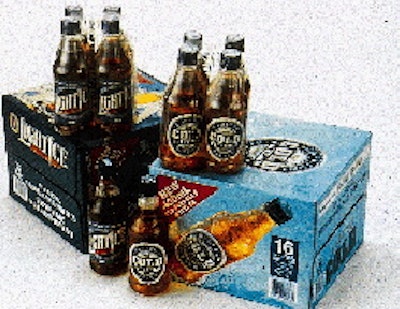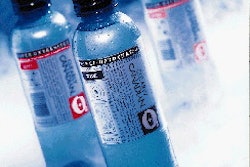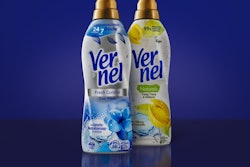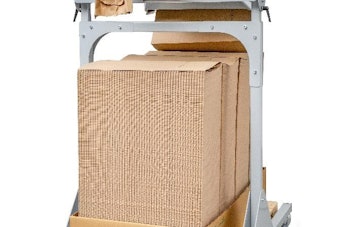
38, or packworld.com/go/beer for this and other related stories mentioned below).
Once again, the 31.5-g bottle with 28-mm neck finish comes from Containers Packaging (Abbottsford, Victoria, Australia). It lacks the words "CUB" and "Cold" embossed on the neck, but essentially it's the same bottle as the one used for Carlton Cold: injection stretch/blow-molded polyethylene terephthalate with an exterior spray coating of epoxy amine. The Bairocade(TM) coating is from PPG Industries (Pittsburgh, PA). Unrefrigerated shelf life remains 100 days.
Both Carlton Cold and Light Ice are sold in shrink-wrapped bundles of four, four bundles per case. Selling price is A$19, or $2.38/L (U.S.$12.28, or $1.53/L). That compares to a case of 24 glass bottles that sells for A$21, or $2.34/L (U.S.$13.57, or $1.51/L). Copy on the case touts the unbreakable nature of the plastic bottles. Supplied by Visy Board (Victoria, Australia), the cases are B-flute corrugated with a liner preprinted offset in five colors. CUB's Warwick Field, manager of packaging, says the case, like all CUB cases, is made of 100% recycled material, most of it post-consumer.
The brewer plans to continue its thrust into plastic bottles. "We have some technical developments we're pursuing to expand both the range of beverages in this technology and also the variety of sizes," says Field. He adds that "sterile filtering" and cold-filling, not tunnel pasteurization, will remain CUB's technology of choice.
Field continues to favor coated PET over multilayer barrier bottles because he's convinced that easily removed coatings make the bottle more easily recycled. With one eye on the Internet, he's tracking other brewers who are testing plastic beer bottles. He's also eager to hear what the environmentalists are saying. This is why he's closely watching Miller Brewing in the U.S.
Milwaukee-based Miller, of course, has been testing its five-layer barrier bottle for three of its brands in eight cities since November. First out were 1-L and 20-oz sizes, followed quickly by a 16-oz bottle, all from Continental PET Technologies (Florence, KY). Miller claims four-month shelf life for this bottle.
Lately, a three-year-old organization called the Grassroots Recycling Network--recycling and community activists advocating policies to achieve zero waste and create jobs from discards--has attacked the Miller bottle as "a disaster for plastics recycling if introduced nationally." GRN has no quarrel with the three layers of PET in the bottle. But the group worries about color, the bottle's barrier material, the label and the closure.
While Miller Genuine Draft is in a clear bottle, Miller Light and Icehouse bottles are amber-tinted. GRN claims amber bottles could become "serious contaminants in clear PET streams." GRN also objects to the barrier material (presumed to be nylon, though Miller isn't saying) because it has not been tested thoroughly for compatibility in today's PET stream. Third, GRN fears that the aluminum closure and metallized label will be difficult to remove and could "cripple plastics processing systems." And finally, GRN would like to see some recycled content in the multilayer bottle.
Miller spokesman Scott Busson tells PW that it is "erroneous" to suggest his company is oblivious to the recycling issue.
"We've worked closely not only with Continental PET but also with organizations like NAPCOR [The National Assn. for Plastic Container Recovery] to make sure these bottles meet all reasonable recycling standards. The problem is, we don't have anyone ahead of us who's laid the groundwork. We've done extensive lab testing, but at some point you need real-world analysis."
Busson agrees that including post-consumer resin makes sense--but not until the bottle has emerged from its test phase. He also says the closure issue isn't about the cap itself, but the breakaway ring that stays on the bottle. Says Busson: Miller is exploring alternatives.
Miller is not the only brewer using Continental PET Technology's bottle. The firm also supplies a five-layer PET/polyamide barrier bottle to Brasseries Heineken, a French division of the giant brewery that's based in the Netherlands. And as PW goes to press, Continental is scheduled to visit with CUB's Field.
"I have no problem with their front-end technology," says Field. "For barrier and shelf life it's excellent, and we've demonstrated that in tests. My problem is with the back end. Until they come up with a suitable bottle-to-bottle recycling scenario, I have big problems with that technology."























